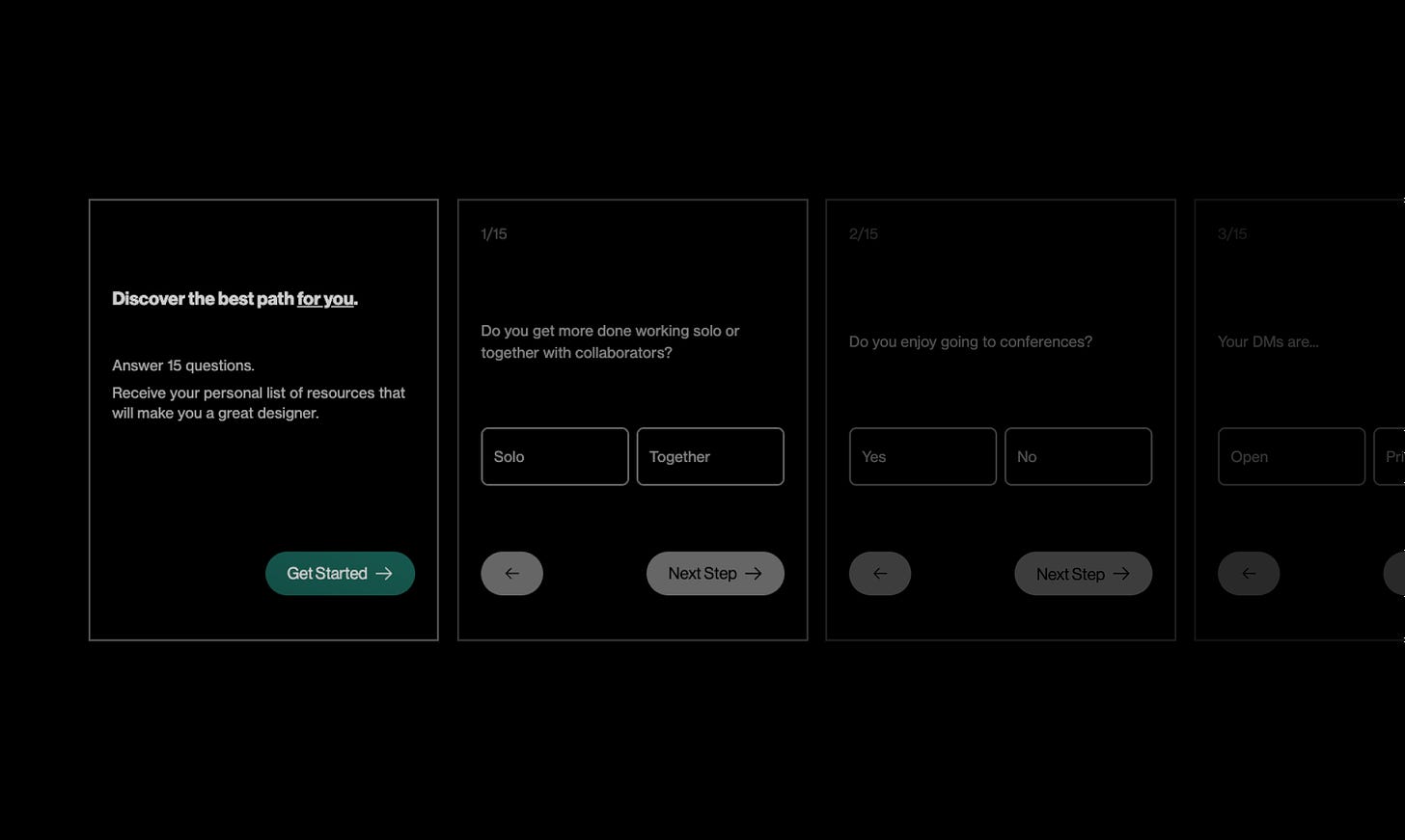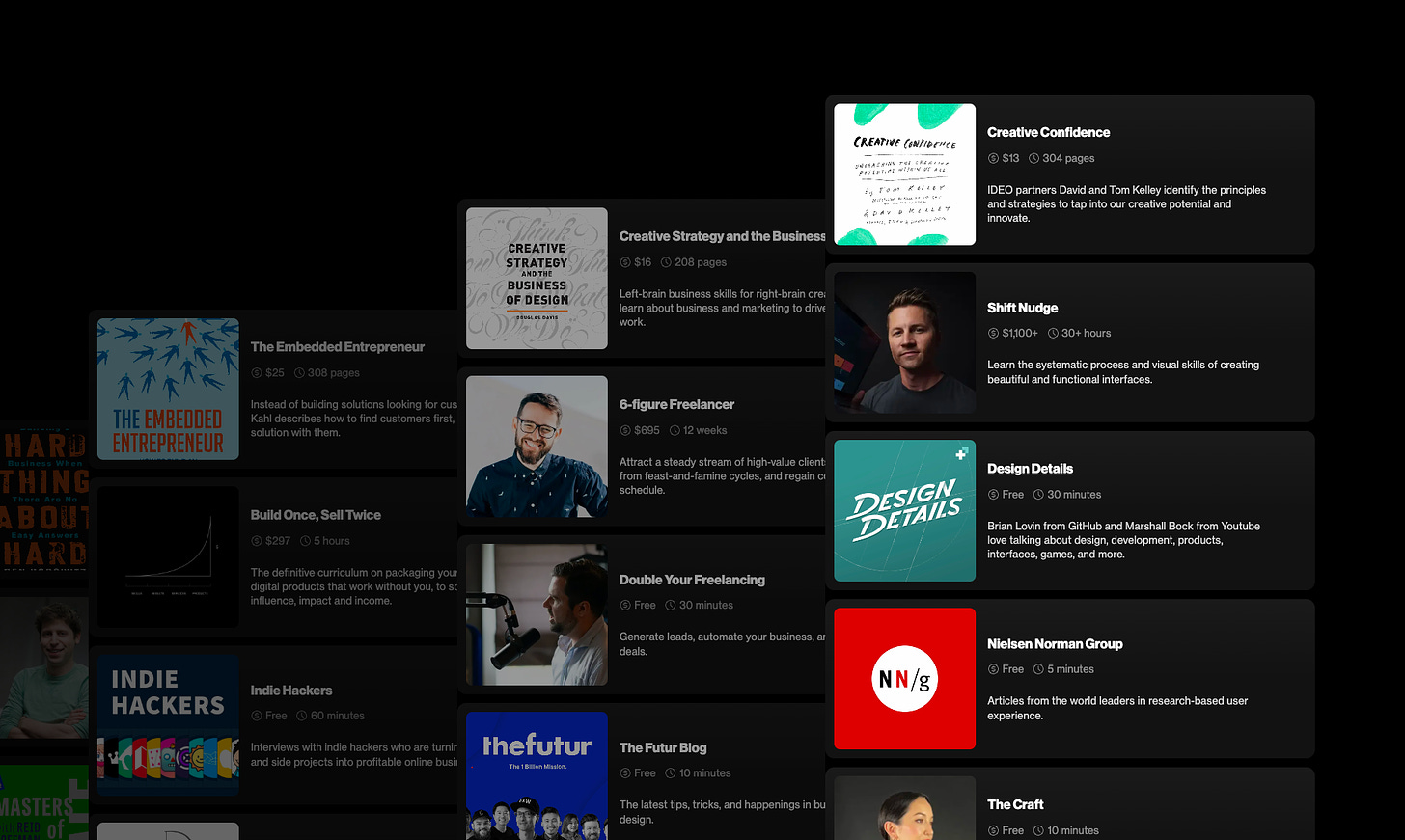Introducing: Design Navigator
I have been designing for 20 years, and studying the design profession for 10 years.
Many times, over the years, I felt blocked and unable to progress. As a result, I reformed my career more than once: I moved from freelancing to academia, and recently, to entrepreneurship and the creator economy.
Transitions like this are challenging. Few people make them – most of us stick to one career path. Most education and advice we receive is specific to one path. Most of us have no idea how these different paths involve major differences in thinking and practice.
If you're just starting out, the challenge is even worse. Most of us don't even pick consciously between options like employment and freelancing, because we don't know what the options are to start with. We accept what fate provides.
Make no mistake: how you do your work is an important decision, as important as what you do. The choice of being an employee, freelancer, or founder is not simply doing the same work in different clothes. It means to immerse yourself in different ecosystems, resources, and communities.
These are different worlds in the multiverse of design.
The good news is, it's possible to have great success in any of these worlds.
The bad news is that success comes from commitment. The skills, resources, and connections you accumulate in a particular world compound over time. But move between worlds, and you'll start over.
This is why it's important to choose your world correctly.
My Story
I started designing when I was 15 years old.
Like any teenage boy, I loved computer games. Then I discovered programming and Photoshop. The possibility to create my own games and apps was far more exciting than playing games that were ready-made.
I made my first money as a freelance web designer. In the early years, when resources like Design Disciplin, The Futur, and Flux Academy did not exist – before "UX/UI Designer" was even a job title – I struggled to meet my challenges. To level up, I signed up for grad school.
Grad school was not what I expected: surprising limitations, as well as surprising opportunities. I expected to become a better designer and builder. Instead, I unlocked growth when I became a good citizen, adopting the values and customs of my academic community – not a designer, but a a scholar of design.
Nevertheless, 10 years ago, academia was a good platform to grow as a creator and innovator. Today, technologies and cultures like remote work, online communities, and the creator economy give us objectively better platforms for creative ambitions. And like before, succeeding in this new world depends on letting go of old ways, to build new priorities, relationships, and practices.
In the course of these moves, I gained a unique perspective on the different worlds within the multiverse of design.
Today, I'm excited to present a tool and resource that I wish was available to me. It would have made my life easier when I started out as an aspiring creative, and later when I moved between different worlds of creative professions.

Design Navigator
Design Navigator is a resource I developed to help designers choose their world and excel in it.
Design Navigator gives you two things: First, a questionnaire to help you think about what matters to you, what you find joyful, and what you find challenging. And based on how you answer it, Design Navigator provides you with a set of resources, tools, and thought leaders that may guide you in your optimal path.
Like Design Disciplin at large, Design Navigator focuses where design meets technology: UX, UI, web, interaction, and digital product designers will find the most value in the resources we curated. But the tool will inspire all.
I curated the resources we included in Design Navigator myself, based on my own experience learning from them. These are the books, courses, podcasts, websites, and people that I have learned the most from. They have made a remarkable difference in how I think and operate as a designer, entrepreneur, and creator.
Of course, my choices have been stress-tested as well: I owe a lot to Fabio Cassisa, who has done thorough research to make sure we are not missing anything, and to my friends – including very accomplished design professionals and former guests on the Design Disciplin Conversations – who have helped me refine the selection. And while we're on the subject, I should thank Ben Issenman of Supercreative and Ran Segall of Flux Academy for creating DesignerPaths, which served as the template for Design Navigator.

How to Use Design Navigator
To make the most out of a resource like Design Navigator, it's best to question it rather than follow it.
The questionnaire we designed to help you think about what matters is not meant to be a definitive evaluation of who you are. Regardless of the result you get, I encourage you to explore all of the worlds and all of the resources we curated – for freelancers, founders, creators, and valued team contributors.
There are no tools that can tell you how to live your life by answering a few questions. But learning about the different worlds of the design profession, exploring all of the resources we gathered to guide the four paths, will help you compare each of them and find your own way.

The Next Level
Doing research for Design Navigator created a massive library of resources for designers. But the very purpose of Design Navigator is to find focus, meaning a small selection, not a horde.
For designers who want more, we are offering the full Design Navigator Library as a premium offering. It contains a Notion database with 100+ resources that help designers excel in their chosen path – as freelancers, founders, creators, or valued team members.
You can access the complete Design Navigator Library through a one-time purchase on Gumroad. But you can also get it for free, if you are a member of the Design Disciplin Community. Community members also get early access to our upcoming products, and can reach me directly with suggestions at any time.
We're very proud to launch Design Navigator, our first digital product, and the Design Navigator Library, which is the first of our premium offerings for our community. We had a lot of fun and learned a lot while building it.
If you'd like to give us feedback or suggestions, please find us on Twitter as @designdisciplin and join the discussion.
Before we go – Design Navigator is live on Product Hunt! This is our first Product Hunt launch. If you're a Hunter, we appreciate your support.


